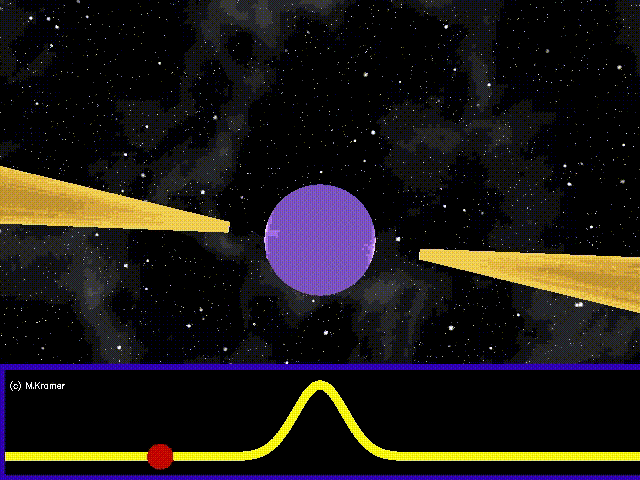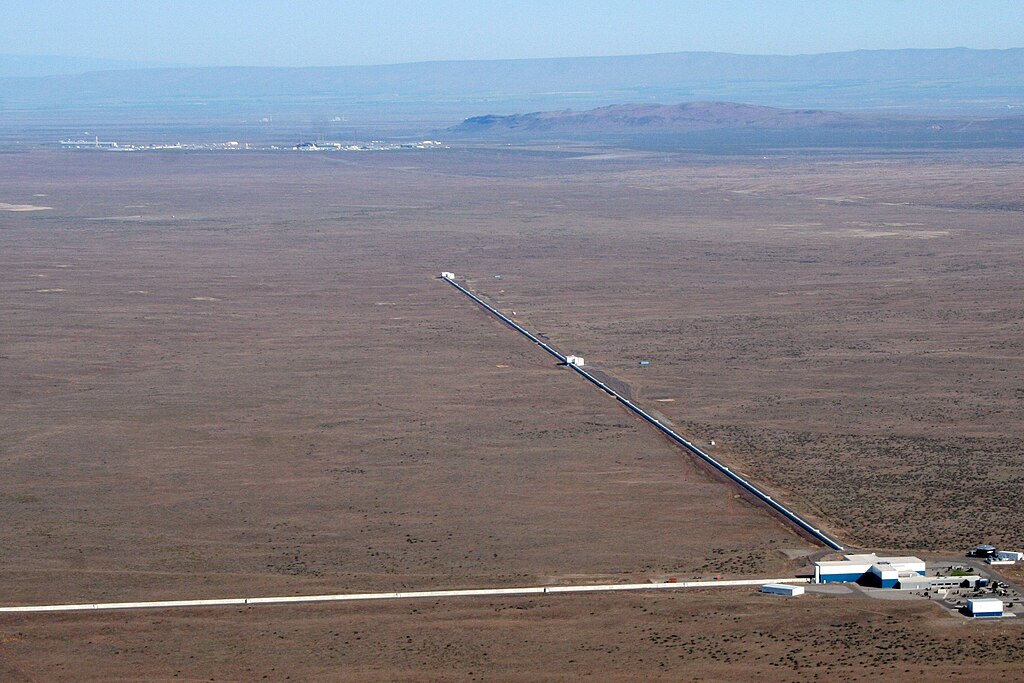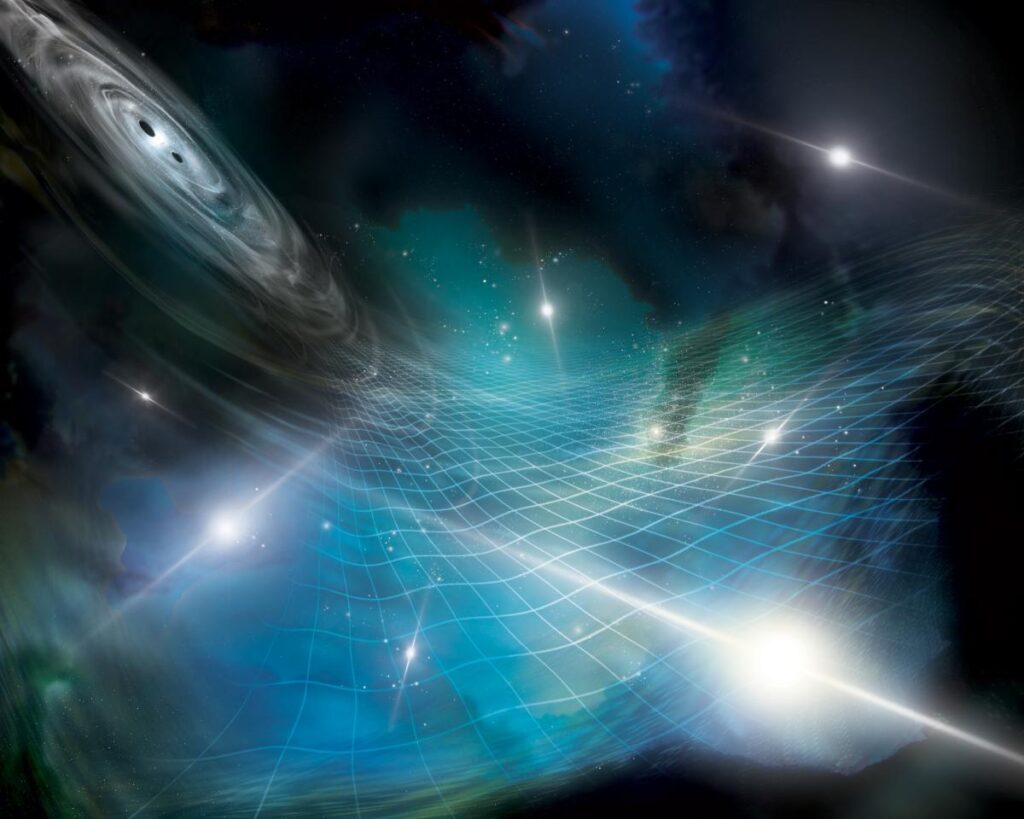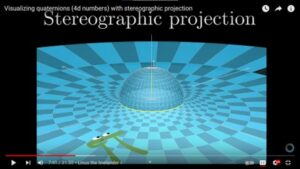
Illustration of the fabric of spacetime bending in relation to massive objects. Spacetime consists of physical information, which is conserved. Some now question whether information of the gravitational effects of massive objects like the Earth is also preserved. Image: NASA
By James Myers
A recent cover feature of New Scientist Magazine asked the question, “Does Spacetime Remember?”
This was not to question the scientifically accepted fact that the universe conserves information, but whether the gravitational imprint of massive objects on the spacetime fabric is preserved in the universal memory. TQR posed a similar question, in an article published last December.
The question is prompted by a recently-detected “background hum” of the universe, a discovery that employed the latest technology to measure gravitational effects on beams of energy from pulsars. A pulsar is a neutron star that emits powerful light energy as it rotates rapidly. A neutron star is the remnant of a supernova explosion, which leaves a black hole where a burning star (like our Sun) once stood. The gravitational effects of such explosions appear to survive for a long time – over 15 years as now observed – in gravitational waves.

Illustration of a pulsar, a high-energy light beam emitted from a neutron star. Image: Wikipedia
What are Gravitational Waves?
Scientific evidence of gravitational waves caused by the collision of two black holes and resonating through the spacetime fabric of the universe – somewhat like the ripples caused when a stone is dropped in a pond of water – was announced in 2016.
The observations were made in 2015, 100 years after Einstein’s theory of general relativity, by the LIGO detectors in Hanford, Washington and Livingston, Louisiana. LIGO is the abbreviation of Laser Interferometer Gravitational-Wave Observatory, which uses incredibly sensitive mirrors spaced four kilometres apart to detect gravitational changes equivalent to less than one ten-thousandth of the charge diameter of a proton.
“Gravitational waves are generated by astronomically dense objects in our universe, typically in orbital motion around each other. As these waves travel through space, they physically stretch and compress the fabric of space-time itself,” Oregon State University astrophysicist Dr. Jeff Hazboun told Reuters.

LIGO detector at Hanford, Washington State, U.S. Wikipedia
According to LIGO’s website, “Gravitational waves carry information on the motions of objects in the universe.”
With the first observation of gravitational waves in 2015, gravitational wave astronomy is a new addition to traditional methods that detect light waves of varying frequencies. The collisions of black holes and neutron stars that have produced detectable gravitational waves also produce sounds, captured by LIGO, including the now-famous “chirp.”
Everything is Vibration: The Universe Has a Newly Discovered Background “Hum”
When a gravitational wave from one source collides with a gravitational wave from another source, the result as we can imagine would be a combination that would ripple, or vibrate, through the fabric of spacetime.
Imagine dropping two stones into a pond of water, and watching their ripples connect and change shape – influenced more by the wave from the larger stone and the stone with the greatest momentum. In this way, gravitational waves would “harmonize” with each other, vibrating in a new frequency that is the combination of both. All physical motion in the universe is ultimately harmonized, as Isaac Newton observed in his third law of motion, which says that for every action there is an equal and opposite reaction. (More precisely, the third law states: “If two bodies exert forces on each other, these forces have the same magnitude but opposite directions.”)
It is in harmonization that the universe conserves its energy, for the same fundamental reason it conserves information: because energy has nowhere else to go.
Arvin Ash explains harmonic oscillation in this YouTube Short with the example of a ball at the end of a spring, oscillating equally to the right and the left of the vertical line. Extend the analogy to quantum mechanics by replacing the ball with a single quantum of energy, and the straight line – where the quantum moves the fastest (the speed of light) – with the boundary of spacetime.
Energy conservation is illustrated in a process called harmonic oscillation, which divides the total energy of a system between its kinetic and potential components.
Two types of energy are conserved: kinetic energy (which is present in the actual physical motion of the object) and potential energy (which is the theoretical total of all possible energy for the object).
In a recent blog, University of Oxford physicist Dr. Vlatko Vedral observed that, “The universe is made up of a stupendously large number of quantum harmonic oscillators each representing a degree of freedom of the respective underlying field (the electromagnetic, the electron field and so on).”
In physics and chemistry, a degree of freedom is an independent physical parameter in the formation of the state of a physical system. The set of all states of a system is known as the system’s “phase space,” and the degrees of freedom of the system are the “dimensions” of the phase space.
Dr. Vedral provides the analogy of two grandfather clocks placed against the same wall, where the vibration from the swinging of the pendulum of one clock transmits through the wall and synchronizes with the second clock, whose pendulum as a result swings with the same frequency.
As he explains it, atoms are “also like the two grandfather’s clocks, with the electromagnetic field in-between playing the role of the wall that allows the energy (photons) to propagate in-between (albeit, photons go at the speed of light, not sound). All interactions in quantum physics are described this way. There are particles (pendula) which interact with other particles (other pendula) through mediators (which are, surprise surprise, chains of yet more coupled pendula!).”
Recently, researchers have identified a consistent universal background “hum,” or vibration, of gravitational waves that lasts for a long time.
Evidence was gathered by observing the regular, measurable intervals of energy from 68 pulsars. The time differences for light energy to arrive at detectors tracking the array of pulsars provided evidence of continuing vibration of gravitational waves. Pulsars are considered reliable sources of such information because the regularity of their pulses of energy makes them excellent timekeepers, as TQR noted in its January feature on advances in timekeeping.
The finding was published in Astrophysical Journal Letters, based on 15 years’ worth of data obtained from the North American Nanohertz Observatory for Gravitational Waves (NANOGrav) Physics Frontiers Center (PFC), a collaboration of more than 190 scientists from the United States and Canada.
“We have solid evidence for a hum of gravitational waves in a new band of the gravitational wave spectrum. These frequencies are 10-12 orders of magnitude smaller than those detected by LIGO, and have wavelengths light years long,” said Dr. Hazboun, a lead author of one of the papers.

Artist’s interpretation of an array of pulsars being affected by gravitational ripples produced by a supermassive black hole binary in a distant galaxy. Image: Aurore Simonnet for the NANOGrav Collaboration
The “new band” that Dr. Hazboun describes is a unique frequency without an identifiable source, at least so far.
Efforts are underway to pinpoint the cause, which some theorize may be the result of pairs of supermassive black holes orbiting each other and producing a continuous low-frequency vibration rather than a single, higher-frequency output that emerges from a collision.
Dr. Hazboun told The Quantum Record that the long-lasting, low-frequency waves in “the nanohertz band (waves with periods of about 5-30 years) will originate from completely different sources than those in the ground-based detector band,” measured by LIGO. He explained that the most likely source is from orbiting supermassive black holes, although it is also possible that the waves originate from physical interactions that occurred just after the Big Bang and describe “new physics.”
If the new, lower-frequency band is the combination of several individual sources, we might imagine one single sound emerging from the symphony of sounds caused by objects colliding and vibrating in the universe. These could include the simplest of collisions, like your foot on the ground as you walk, to asteroid impacts, and to the highest-energy vibrations of colliding black holes and supernova explosions.
“The large number of pulsars used in the NANOGrav analysis has enabled us to see what we think are the first signs of the correlation pattern predicted by general relativity,” said Dr. Xavier Siemens, professor of physics in the OSU College of Science. “We can use those pulsars as clocks spread out through the sky, and we can see how the ticking of the clocks changes from gravitational waves passing through our galaxy.”
While LIGO has recorded multiple gravitational wave events since 2016, NANOGrav’s website observes that the “15 years of pulsar observations are showing the first evidence for the presence of gravitational waves, with periods of years to decades.”
In other words, gravitational waves may be a permanent, rather than temporary, feature of spacetime. To test the conclusions, researchers will be expanding the data set to 80 pulsars over 24 years.
The Universal Law of Conservation of Information Suggests Universal Memory: Is It Holographic?
It is scientifically agreed that information can neither be created nor destroyed in the Universe. There is no source other than the Universe to create information, and there is no place for it to discard data. Therefore, information is always conserved – as a recognized universal law – but the relationships between data points that comprise information remain capable of change within space and time.
Some time ago, there was a famous debate between physicists Stephen Hawking and Leonard Susskind on Hawking’s theoretical proposition that memory of a physical object would disappear once it is drawn into a black hole from which light can never escape.
Hawking’s position was based on the theory of general relativity, and proposed that the very slow evaporation of a black hole (which we now call Hawking radiation) would contain none of the information that fell into the hole. Susskind argued from the perspective of quantum mechanics that information must always be conserved, even in black holes which appear to defy Einstein’s famous theory.
The debate resolved in a compromise. Susskind adapted the holographic principle, advanced by Nobel Prize-winning physicist Gerard ‘t Hooft, to show that physical memory could be maintained at the boundary of a black hole. It would not, however, be retained in the four dimensions of spacetime that we know, but only in two dimensions, on the boundary of the black hole which is called the event horizon. Susskind wrote a book about the debate, entitled The Black Hole War.

Stereographic projection is illustrated in a YouTube video by 3Blue1Brown on the subject of quaternions and three-dimensional numbers, which are now widely used in creating video animations.
If the holographic principle holds, what would happen to energy, consisting of photons of light, reflected from the information that is recorded in two dimensions on the black hole’s event horizon?
It’s an open question, but we might imagine it similar in operation to a holograph that projects pixels of light from a surface into three dimensions of space and one dimension of time. The result might be similar to a stereographic projection.
In fact, holography is being pursued as a potential technology for high-capacity computer data storage.
Holographic data storage would record information throughout the entire volume of the storage medium (which could, for example, be spherical), and allow different configurations of data to exist in the same area by utilizing light at different angles. Additionally, holographic data storage would allow recording and retrieval of data in parallel, eliminating a significant time delay in typical optical data storage-and-retrieval mechanisms.
So does the universe have a memory?
If you think of the universe as a data storage mechanism, one that creates, stores, and retrieves data for its operation simultaneously (or in parallel), then you might imagine yourself as the observer included in the universal dataset. All data being conserved, the data stored in the universe include the record of you, not just as a physical being but also as a non-physical mind thinking about the physics of the universe (among many other things both rational and irrational).
It’s a somewhat mind-blowing, but perhaps entirely logical, image – given the universal law of conservation of information of which you are part.



